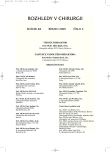An Inflammatory Aneurysm of the Abdominal Aorta
Zánětlivé aneuryzma břišní aorty
Zánětlivé aneuryzma břišní aorty je vzácné onemocnění postihující asi 3–10 % populace trpící výdutí břišní aorty. Bakteriální mikroorganismy, především Salmonella, Staphylococcus aureus, Escherichia coli, patří k hlavním etiologickým agens tohoto onemocnění. V řadě případů je však etiologie nejasná a jistou roli zde hraje pravděpodobně i autoimunní a genetická dispozice. K hlavním diagnostickým prostředkům vedle klinického obrazu patří ultrasonografie, výpočetní tomografie a magnetická rezonance. K základním léčebným postupům patří otevřená resekce zánětlivého aneuryzmatu s odstraněním veškeré infekční tkáně a náhrada protézou, nebo cévním allograftem „in situ“ nebo extraanatomickou rekonstrukcí. K novým postupům pak patří endovaskulární léčba, která je technicky mnohem jednodušší, pro nemocného méně náročná, avšak ponechávající možné infekční ložisko v organismu s nebezpečím dalších následných septických komplikací. Autoři proto doporučují přísně individuální volbu léčby u každého nemocného s tímto závažným onemocněním. Při pozitivních kultivačních bakteriologických nálezech je podmínkou dlouhodobá (minimálně 6týdenní) aplikace antibiotik a pravidelné, dlouhodobé sledování nemocných.
Klíčová slova:
zánětlivé aneuryzma břišní aorty – etiopatogeneze – diagnostika – léčba
Authors:
V. Třeška *; J. Moláček *; B. Čertík *; V. Kuntscher *; J. Ferda **
Authors‘ workplace:
Chirurgická klinika FN v Plzni, přednosta prof. MUDr. V. Třeška, DrSc.
*; Radiodiagnostická klinika FN v Plzni, přednosta doc. MUDr. B. Kreuzberg, CSc.
**
Published in:
Rozhl. Chir., 2005, roč. 84, č. 3, s. 112-116.
Category:
Monothematic special - Original
Overview
Inflammatory aneurysm of the abdominal aorta is a rare disorder, affecting approximately 3–10% of the population with a diagnosis of the abdominal aortic aneurysm. The principal etiological agents of the disorder include bacterial microorganisms, primarily Salmonella, Staphylococcus aureus, and Escherichia coli. However, in many cases the etiology od the disorder remains unclear and, likely, autoimmune and genetic dispositions may play a certain role, as well. The principal diagnostic procedures include ultrasound, CT and MRI examinations. The principal therapeutic procedures include open resection of the inflammatory aneurysm with complete removal of the infectious tissue and its replacement by a prosthesis or a vascular allograft „in situ“ or through an extraantomical reconstructive procedure. New procedures also include endovascular therapy which is technically much simpler, less demanding for a patient, however, it may leave a potential infectious focus in the organism with a risk of further septic complications to follow. Therefore, the authors recommend a strictly individual treatment strategy in each patient with this serious disorder. In case of positive cultivation bacteriological findings, extended (a minimum of 6 weeks) antibiotic therapy and regular, long-term patient follow-up with regular visits, are essential.
Key words:
inflammatory aneurysm of the abdominal aorta – etiopathogenesis – diagnostics – treatment
Labels
Surgery Orthopaedics Trauma surgeryArticle was published in
Perspectives in Surgery

2005 Issue 3
- Metamizole vs. Tramadol in Postoperative Analgesia
- Metamizole at a Glance and in Practice – Effective Non-Opioid Analgesic for All Ages
- Obstacle Called Vasospasm: Which Solution Is Most Effective in Microsurgery and How to Pharmacologically Assist It?
Most read in this issue
- Implantations of Venous Ports – the Latest Advances
- Acute Bleeding in the Crohn’s Disease
- The Malignant Melanoma Metastasis into the Stomach Corpus
- An Inflammatory Aneurysm of the Abdominal Aorta
